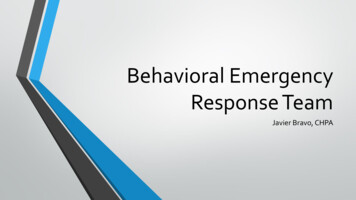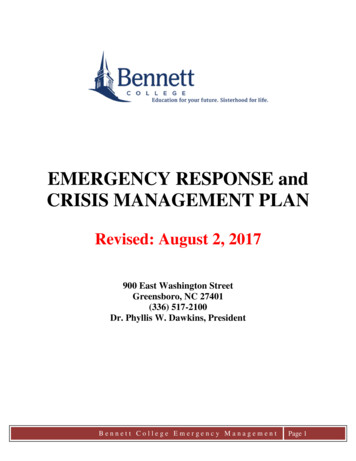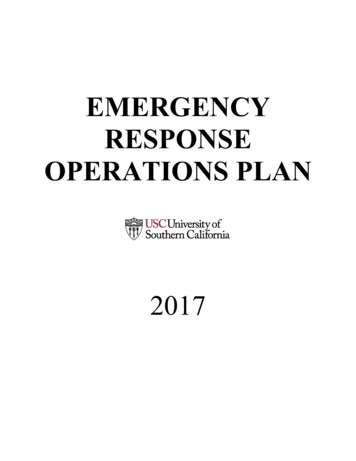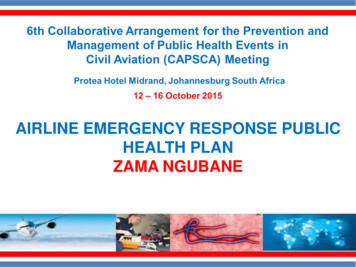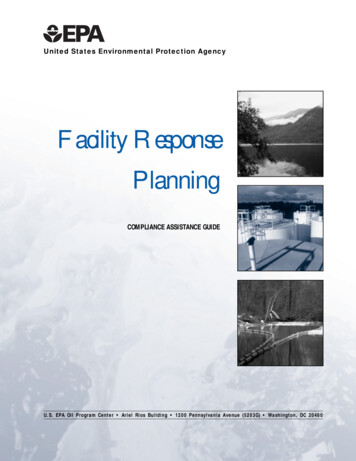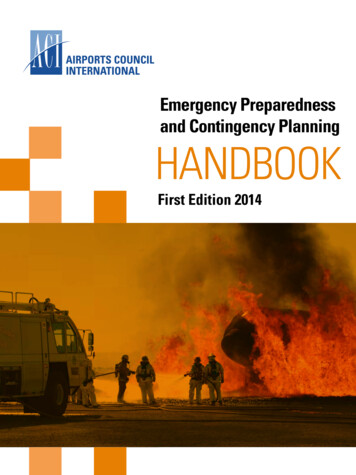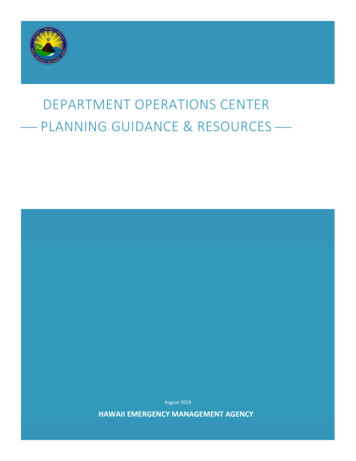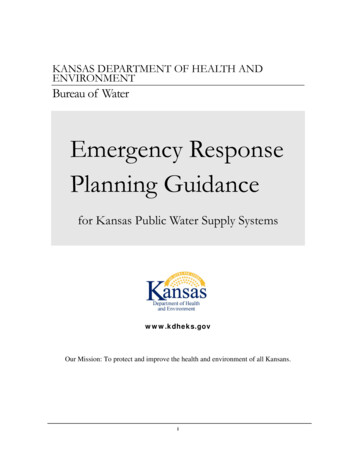
Transcription
KANSAS DEPARTMENT OF HEALTH ANDENVIRONMENTBureau of WaterEmergency ResponsePlanning Guidancefor Kansas Public Water Supply Systemswww.kdheks.govOur Mission: To protect and improve the health and environment of all Kansans.i
KANSAS DEPARTMENT OF HEALTH AND ENVIRONMENTEmergency Response Planning Guidancefor Kansas Public Water Supply SystemsUpdated February 2013KDHE-BOW1000 SW Jackson Street Suite 420Phone 785.296.5504 Fax 785.296.5509ii
ContentsI NTRODUCTI ONANDPURPOSEiiiBACKGROUNDvPRE-EMERGENCY PLANEmergency OrganizationVulnerability AssessmentAssetsPhysical Protection SystemEmergency Water RequirementsCommunicationsPersonnel SafetyTraining, Testing and Up-dating11471012161920POST-EMERGENCY PLANThreat LevelThreat Warning EvaluationActivate the Emergency Response Design TeamSafetyDamage Assessment and Contact for ServicesAction PlansNatural Disasters and Other Significant Events2122232425262729RESPONSI BILI TI ES34PLAN35SECURI TYAPPENDI CESSimplified VA Tool for Drinking WaterAction Plans-ExamplesPairwise comparison matrixKDHE District Office MapGuarding Against Terrorist and Security Threats-EPATopic OutlineAcronymsAdditional ResourcesiiiABCDEFGH
Introduction and PurposeThe purpose of this document is to provide guidance for developing or revisingpublic water supply system Emergency Response Plans (ERPs). An ERP is adocumented plan that describes the actions that a Public Water Supply System(PWSS) will take in response to major emergency events. Emergency watersupply plans are necessary for PWSS to provide adequate potable water duringemergency conditions and restore normal service quickly following an emergencyevent. Emergency conditions may develop as a result of natural or man-madecatastrophes. This guidance document will serve to familiarize waterprofessionals, especially those responsible for PWSS serving populations of fewerthan 3300, with the major components of emergency response plans.All PWSS must develop emergency response plans as required by KAR 28-15-18and authorized by KSA 65-171m. The overall structure of this document isdirected towards an all hazards response. Emphasis is given to a methodology toassess the risk to small PWSS infrastructures from terrorist threats, sabotage,vandalism and natural phenomena. An overview is provided on how to improvephysical protection systems (PPS) to insure the continued provision of safedrinking water. Additionally, the incorporation of action plans in ERP’s isdiscussed.Protecting public health is the primary goal of community drinking watersystems. Having an up-to-date and workable emergency response plan helpsachieve this goal in a crisis situation. Emergency response plans for PWSSinclude several components, all designed to insure an immediate response can bemade to meet the needs arising from an emergency situation. An emergencyresponse plan includes both pre- and post-emergency plans of action. The formerplan includes completion of a vulnerability assessment (VA). The pre-emergencyplan is the mitigation and preparedness part of emergency management. Thepost-emergency plan involves the systematic response to an emergency event,resulting in the resumption of normal operations of the PWSS. This is theresponse and recovery part of emergency management. The KDHE encouragesall PWSS to perform VA’s. ERP’s are required by the KDHE of all systems.There are extensive resources available regarding vulnerability assessmentsand emergency response planning from federal and state agencies. Primaryagencies are the Department of Homeland Security, EnvironmentalProtection Agency, Kansas Adjutant General and the Kansas Department ofHealth and Environment. Appendix A contains the “Simplified VulnerabilityAssessment Tool for Drinking Water.” Appendix B offers examples ofAction Plans. Appendix C offers a Pairwise Model for ranking the needs ofcustomers. Appendix D lists KDHE District Office contacts, and Appendixiv
E provides the EPA “Guarding Against Terrorist and Security Threats:Suggested Measures for Drinking Water Utilities.” For security, Appendix Dis only available at www.waterisac.org. Appendix F is a bullet outline of preand post-emergency plan topics. Appendices G and H respectively provide alist of acronyms and additional resources.v
BackgroundProtection of public water supplies has been a major function of the KansasDepartment of Health and Environment since the agency was formed in1885. The agency’s role has changed over the years as public water supplysystems grew in size and number. The agency’s role of adopting standards,promulgating regulations, and providing technical assistance has become wellestablished. In 1978, the Environmental Protection Agency granted primacyto the KDHE for enforcement of the Safe Drinking Water Act. Beginningin 1982, the KDHE required public water supply systems to conductvulnerability assessments and prepare emergency response plans.The day-to-day management and operation of public water supply systemsgenerally rests with local agencies, municipalities, and rural water districts.The number of public water supply systems regulated by the KDHE are1021 (as of February 2013), and the number of service connections continuesto increase. The success of PWSS is reflected by the rarity of waterborneillnesses.Over the years, the Kansas environment has challenged public water supplysystems. Natural disasters including damaging storms, drought, and floodinghave been well documented. Mitigation efforts have been launched toprevent reoccurrence of the physical destruction and loss of life associatedwith the floods of 1903, 1951 and 1993. The emergence of terrorist threatspresents a new challenge to public water supply systems to maintain publicsafety and confidence.The Kansas Adjutant General has the responsibility for emergency responseplanning and preparedness. This responsibility is captured in the State ofKansas Emergency Operations Plan. The State Emergency Operations Plandelineates expectations and coordinates state and local agencies respondingto emergency events. Local emergency response plans, required by law,detail specific response actions local officials will invoke. In the event of aPresidential Declaration of Emergency, the National Response Plan wouldbe activated to coordinate response activities of agencies at the federal level.History has shown public water supplies will continue to be threatened bythe Kansas environment. Terrorist actions of recent times warn of the needto be vigilant in assessing threats and reducing risks of manmade disasters.Regardless as to the source or cause of a disaster, it is in the best interests ofpublic water supply systems and Kansas citizens to plan and prepare foremergency events.vi
Pre-Emergency PlanEmergency OrganizationEmergency Response Plan Design TeamSuccessfully responding to an emergency event is largely dependent on preemergency planning by management staff of the public water supply system(PWSS). The management staff of PWSS will vary in number from one ortwo individuals with multiple responsibilities, to large organizations withmany individuals contributing to the mission of the organization. Regardlessof the size of a PWSS, there are commonalities when planning for andmanaging an emergency event.All PWSS should form an Emergency Response Plan Design Team. AnEmergency Response Lead (ER Lead) should be designated and responsiblefor coordinating the design team and managing the Emergency ResponsePlan (ERP). The ER Lead will be the main point of contact and decisionmaker during a major event. This person will have responsibility forevaluating incoming information, managing resources and staff, and decidingon appropriate response actions. The ER Lead will also have theresponsibility of coordinating efforts with emergency response partners.The design of the ERP and resulting Physical Protection System (PPS) isdependent on the community at large from citizens to utility administrators.It is important to establish a design team that crosscuts the community tosome degree. Obvious design team members include PWSS staff, firstresponders and local law enforcement agencies, but the partnerships neededfor an effective system are much broader. A design team for a small PWSSwill consist of all those who can contribute to the successful design of anERP and PPS. Design teams for extremely small systems may consist of afew individuals with broad responsibilities, whereas, teams for larger systemsmay consist of a number of subcommittees dealing with specific issues. Anall-inclusive approach to developing partnerships builds confidence that rolesand responsibilities will be understood and carried out during an emergencyevent.Consider including the following individuals and organizationrepresentatives. City/County personnel - mayor and city manager, commissioners, rural waterboard members, legal counsel, planners, water plant superintendent,wastewater plant superintendent, public works superintendent, health officer,city/county clerk, related maintenance personnel, chief of police, sheriff, firechief, local emergency planning committee coordinator, HAZMAT1
coordinator, hospital administrators, long term health care providers, animalshelters, and librarian. State/Federal - KDHE District Engineer, Ks. Department of Agriculture,Highway Patrol, Ks. Department of Transportation, Ks. Division ofEmergency Management Homeland Security Regional Coordinator, Ks.Department of Wildlife and Parks, Social and Rehabilitation Services, KBI,and US Army Corps of Engineers (USACE). Community representatives - school principals, industrial and service clubrepresentatives, doctors, dentists and veterinarians, amateur radio/CB clubs,Red Cross, print and broadcast media, chamber of commerce and interestedcitizens. Rural personnel - industry representatives, irrigators, haulers, and townshipfire chiefs. Neighboring communities - city and county emergency coordinators, andrepresentatives of neighboring PWSS. Suppliers for key PWSS equipment, parts and chemical needs.The design team will identify their chain of command, command post locations,list of members and alternates with need-to-know identities along with contactinformation for each. Regardless as to their individual or organizationalinvolvement, each entity that may have a role in the ERP will at a minimum havecontact information for the Emergency Response Lead and the Alternate Lead.The ERP should include:Name of ER LeadName of Alternate ER LeadWork Telephone No.Work Telephone No.Home Telephone No.Home Telephone No.Cell Phone No.Cell Phone No.Pager No.Pager No.Radio Call No.Radio Call No.E-Mail addressE-Mail addressTThe ER Lead or the Alternate ER Lead will need to be reachable 24/7.2
Incident CommandUse of the Incident Command System (ICS) is recommended for managingan emergency event. Briefly, ICS is the model tool for command, control,and coordination of an emergency response and provides a means tocoordinate the efforts of first responders as they work toward the commongoal of stabilizing a major event and protecting life, property, and theenvironment. ICS uses a well-defined command structure in order to specifyroles and responsibilities in responding to a major event.When using the ICS, the main contact person and decision-maker is theIncident Commander (IC). At the PWSS level, the ER Lead has the role ofIncident Commander, unless the incident is of such significance that local,state, or federal officials take over the command. The KDHE, Director,Division of Environment assumes the role of IC for the Division ofEnvironment. The person designated as the Incident Commander may shiftfrom person-to-person and agency-to-agency as situations progress throughan emergency event. The changing of IC should be done smoothly withroles and responsibilities clearly understood. The design team should addressroles, responsibilities, and the command structure when forming thepartnerships with key organizations.The Department of Homeland Security (DHS) is implementing the NationalInformation Management System (NIMS) for coordinating federal, state andlocal responses to terrorist events. The NIMS uses the ICS. Moreinformation on ICS can be obtained from FEMA athttp://training.fema.gov/EMIWeb/IS/is195.asp and www.dhs.gov.Cooperative AgreementsWorking relationships established through an effective design team will leadto opportunities to share resources. Cooperative agreements or mutual aidagreements such as KSMAP (Kansas Mutual Aid Program for Utilities)should be considered with other PWSS for obtaining alternate water sources,exchange of equipment and repair parts, and sources of processingchemicals. Protecting assets of a PWSS in advance of any actual threat,through cooperative agreements, is encouraged.The ERP should identify equipment that can significantly lessen the impactof a major event on public health, and protect the safety and supply ofdrinking water. Based on the findings of the vulnerability assessment (VA),the ERP should identify how and where to find equipment, replacementparts, and chemicals needed to respond adequately to a particular threat. TheERP should contain an inventory of equipment on-hand (e.g., pumps); repairparts; chemical supplies for normal maintenance and operations; and detailson mutual aid agreements. Mutual aid agreements with other PWSS shouldbe used to provide redundancy for essential equipment, parts, and chemicalsnot maintained in inventory.3
Vulnerability Assessment (VA)PurposeVulnerability assessments (VA’s) help PWSS evaluate susceptibility topotential threats and identify corrective actions that can reduce or mitigatethe risk of serious consequences. A properly conducted VA will identifynatural and man-made threats; the potential targets of threats; the degree ofrisk from threats, and the level of protection provided by existing PPSs.Threats may be from vandalism, insider sabotage, or terrorist attack.Threats to PWSS may also be caused by human error, acts of nature and lossof services. Vulnerability assessments for water systems take into accountthe vulnerability of the source water, transmission, treatment, anddistribution systems. VA’s also consider the impacts on the surroundingcommunity related to attacks on the water system. An effective vulnerabilityassessment serves as a guide to a water utility by providing a prioritized planfor security upgrades, modifications of operational procedures, and policychanges to mitigate the risks and vulnerability to a utility’s assets. Thevulnerability assessment provides a framework for developing risk reductionoptions and associated costs. To ensure security objectives are being met,water systems should review their vulnerability assessments periodically toaccount for changing threats or system modifications.Determine RisksPreferably, a vulnerability assessment is a risk-based analysis evaluating thesusceptibility and the probability a threat may materialize and disrupt operation ofa PWSS. Vulnerability assessments can be qualitative or quantitative. Eachinvolves the evaluation of risks associated with potential threats to a PWSS. Also,each includes an assessment of the existing PPS's ability to be successful indefending against the threats.Once the greatest risks are identified, the water supply ER Lead and the ERPDesign Team can evaluate which deterrents can be added to the PPS to reducethe risk where they will provide the greatest impact. By addressing the highestrelative risk first, the system should achieve maximum benefit for resourcesexpended. The vulnerability assessment will also help to identify those areaswhere risk is acceptable and can be planned for via the PWSS’s ERP.The following are basic elements of vulnerability assessments common to allPWSS. Characterization of the water system, including its mission andobjectives;4
Identification and prioritization of adverse consequences to avoid; Determination of critical assets that might be subject to emergencysituations that could result in undesired consequences; Assessment of the likelihood, qualitative probability, of such emergencysituations, Evaluation of existing countermeasures; and Analysis of current risk and development of a prioritized plan for riskreduction.The vulnerability assessment process will range in complexity based on thedesign and operation of the PWSS. The nature and extent of the vulnerabilityassessment will differ among systems based on a number of factors,including system size, potential population affected, source water, treatmentcomplexity, system infrastructure and other factors. An effective VA willidentify threats that may impact a PWSS, the specific targets or assets thatmay be impacted, the relative risks of the threats, and the ability of the PPSto limit adverse outcomes of emergency situations.The manner in which the vulnerability assessment is performed is determinedby each individual water utility. Remember, throughout the assessmentprocess, the ultimate goal is twofold: safeguard public health and safety, andreduce the potential for disruption of a reliable supply of pressurized water.Resources for conducting Vulnerability Assessments –The KDHE, Division of Environment, Bureau of Water has prepared the“Simplified Vulnerability Assessment Tool for Drinking Water”, AppendixA. The EPA has a number of resources at its web rity/Response to Vulnerability Assessment FindingsThe results of the VA will indicate the vulnerability of the PWSS to identifiedthreats and the level of security offered by the existing PPS. If the existingPPS has not been up-dated since 9-11-2001, it likely will need to be revisedto address terrorist threats. The PPS should address deterrence, detection,delay, and response provisions to mitigate terrorist threats and actions.Action plans should be developed for high consequence events that cannotbe completely prevented by the PPS. Action plans are discussed in the PostEmergency section of this document.5
AssetsThe assets of a PWSS are the components of the infrastructure needed to makethe utility function. Assets include: Physical plant Cyber structure Knowledge base People CustomersA thorough characterization of each of these categories is crucial. Omission ofan essential component could result in the failure of the PWSS. The KDHEDistrict Engineer may be contacted for assistance in identifying PWSS assets.Physical Plant - This includes the infrastructure associated with water sources,treatment, storage and distribution of the water, and other infrastructure thatsupplement the PWSS. The latter includes equipment and supplies fromindividual, commercial, industrial or other government sources water resources.PWSS infrastructure includes land, outdoor structures and buildings with variousutilities such as heating, ventilation, air conditioning (HVAC), electric power, gasand other fuels, water and communication systems and security systems,equipment and supplies for processes, pumps, storage and water distribution,maintenance operations, laboratories, transportation, environmental protection,fire and police protection.Cyber Infrastructure - This includes the Supervisory Control and DataAcquisition (SCADA) system as well as other information technology support forthe PWSS and the PPS along with their applications to all aspects of theoperation, monitoring and maintenance of the two systems. Although part of thephysical plant, information technology is listed separately because of itsvulnerability to cyber threats.Knowledge Base - This includes the business-critical and O&M relatedinformation including personnel, customer, government and procurementrecords; technical reports; as-built drawings, site plans and maps; operating,safety, environmental, conservation, drought and other emergency procedures,O&M manuals, deeds, legal agreements and contracts. During an emergencyevent, basic technical
Pairwise comparison matrix C . KDHE District Office Map D . Guarding Against Terrorist and Security Threats-EPA E . Topic Outline F . Acronyms G . . public water supply system Emergency Response Plans (ERPs). An ERP is a documented plan that describes the actions that a Public Wate
